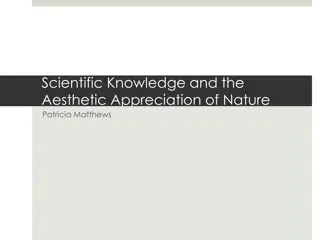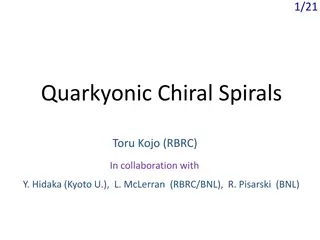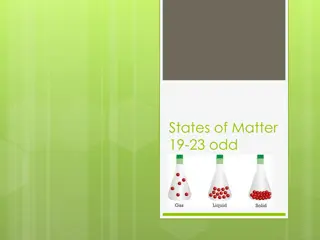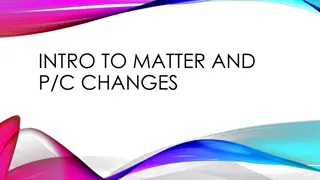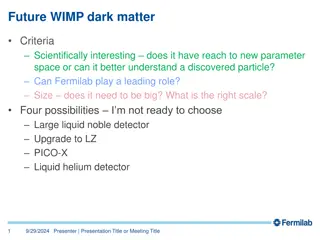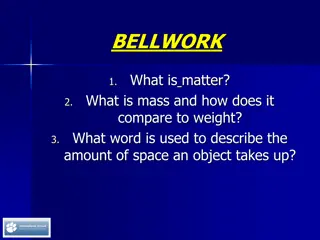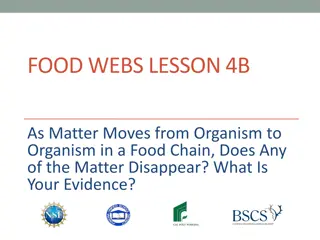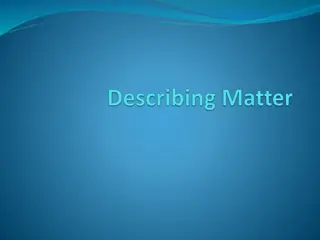Exploring the Nature of Matter: Unit Project Overview
Embark on a journey to understand the structures and bonds of matter through a comprehensive unit project. Delve into atoms, molecules, compounds, pure substances, mixtures, phases of matter, properties, periodic table, and conservation laws. Explore matter classification and phase changes' relationship to conservation of matter while preparing for assessments and project submissions.
Download Presentation

Please find below an Image/Link to download the presentation.
The content on the website is provided AS IS for your information and personal use only. It may not be sold, licensed, or shared on other websites without obtaining consent from the author. Download presentation by click this link. If you encounter any issues during the download, it is possible that the publisher has removed the file from their server.
E N D
Presentation Transcript
September 28th2015 page 49 DO: I will be able to my mastery of the nature of matter by completing a unit project over the structures and bonds of atoms, molecules, and compounds; pure substances and mixtures; the phases and changes of matter; the physical and chemical properties and changes of matter; the organization of the periodic table; and the Law of conservation of matter. EQ: 1. Explain 3 different ways that matter can be classified. 2. Explain how phase changes correlate to the law of conservation of matter?
IN YOUR AGENDA WRITE DOWN TEST IN YOUR AGENDA WRITE DOWN TEST THURSDAY OCT 1 & Project DUE WED SEP 30 THURSDAY OCT 1 & Project DUE WED SEP 30 Quick check Quick check Soil is made up of pieces of rocks, wood, decayed plants, and many other materials. Soil is an example of A. An atom B. An element C. A compound D. A mixture
MATTER SUMMATIVE PROJECT 9-14 DUE 10-1 Please use your notes, Power points, and the hands on examples that we use in class (mason jars, marshmallows, pictures etc.) as resources and starting points to use in your work. We will work on this in class Monday after break. Digital projects can be emailed to: Caiken@Paulding.k12.ga.us
UNIT 1 Project Rubric UNIT 1 Project Rubric Standard checklist: Standard checklist: I have investigated the scientific view of the nature of matter through: a. Categorizing matter as either elements, atoms, molecules, and compound molecules; as well as explaining how matter is created through foundational building blocks beginning with atoms. Including being able to explain and break down atoms and their subatomic particles. b. Describe the difference between pure substances (elements and compounds) and mixtures. c. Movement of particles in different states of matter; solids, liquids, gas, and plasma. d. Distinguish between physical and chemical properties. e. Distinguish between physical and chemical changes. f. Explain the organization of the periodic table and its importance and uses in science. g. Explain the concept of the law of conservation of matter. Developing Knowledge Proficient Knowledge Mastery of Knowledge Advanced connections within and across subjects made within the project Sophisticated application of the standard within the project All 7 standards have been investigated and addressed clearly in the project. Objective Made beginning (simple) connection made within the project Intermittent application of the standard within the project. Less than 3 standards checked. Several connections made within the project Solid application of the standard within the project. Less than 5 standards checked. Understanding of Standard(s) ____/ 50 Idea was fully imaginative but was not fully expressed Mostly organized but there are areas for improvement Connections were clear Connections were vague or missing Idea was not developed throughout the activity Un-organized and difficult to follow Connections were clear and concise Idea was fully developed throughout the activity Well organized and accessible to all Clarity of Project _____/25 Medium was not successfully used to explain message Project was not fully developed Unoriginal Medium is well used to support the message Mostly engaging Well rounded but lacks unique qualities Masterfully integrates message and medium Engaging and attention grabbing Sparks new ideas about the highlighted standard Creativity _____/25
Story/Scrap Book: Complete a story book about Matter. Include an explanation of Matter. Provide information and examples of the states of matter and their physical and chemical properties. Additionally you should address the ways matter can change chemically as well as physically. Finally address the elements, atoms, and molecules that make up matter. Create a diagram page about the atom and its subatomic particles and explain about the atom and its components. Then follow up pages with definitions, examples, and illustrations of molecules, compounds, pure substances, mixtures, and the periodic table and how these subdivisions of matter relate to each other and matter. Your book may be strictly informative or a creative representation that will inform and entertain readers. Be sure that your book is correct, colorful, and clean. AT LEAST 15 Pages.
Graphic Organizer Content Map: Create a graphic organizer that explains matter from its most general to most specific terms. From the central idea of matter break down what matter is and how it can be explained. Provide information and examples, give definitions, examples, and pictures that explain: the physical and chemical properties of matter, the chemical and physical changes that matter can undergo, the elements, atoms, elements (explain the element square), atoms (explain sub atomic particles),molecules and compounds that make up matter, pure substances, mixtures, as well as the periodic table and its arrangement. Be sure that your organizer is informative as well as easy to read and follow. Double check that all of your information is correct, colorful, and clearly organized. * AT LEAST five example connections. A template framework is on the next page.
This is a framework that you may use as a starting point if you wish. *Remember to cite sources and to put all information in your own words.
3D Display: Create a 3D diorama or display that represents matter from its most general forms to most specific forms. From the central idea of matter break down what matter is and how it can be explained. Provide information and examples with each 3D description, give definitions and examples that explain: the physical and chemical properties of matter, the chemical and physical changes that matter can undergo, the elements, atoms, elements (explain the element square), atoms (explain sub atomic particles), molecules and compounds that make up matter, pure substances, mixtures, as well as the periodic table and its arrangement. Be sure that your display is informative as well as easy to read and follow. Double check that all of your information is correct, colorful, and clearly organized. *Hint matter is most easily represented 3- demensionally with colorful cereal or candy* The Mason jar display is a really fun way to breakdown PURE SUBSTANCES (compounds and elements) and MIXTURES (homogeneous and heterogeneous)
Prezi or Power Point: Create and informative power point about Matter. Include an explanation/definition of Matter. Provide information and examples of the states of matter and their physical and chemical properties. Additionally you should address the ways matter can change chemically as well as physically. Finally address the elements, atoms, and molecules that make up matter. Create a diagram page about the atom and its subatomic particles and explain about the atom and its components. Then follow up pages with definitions, examples, and illustrations of molecules, compounds, pure substances, mixtures, and the periodic table and how these subdivisions of matter relate to each other and matter. Your book may be strictly informative or a creative representation that will inform and entertain readers. Be sure that your book is correct, colorful, and clean. AT LEAST 15 Slides.




